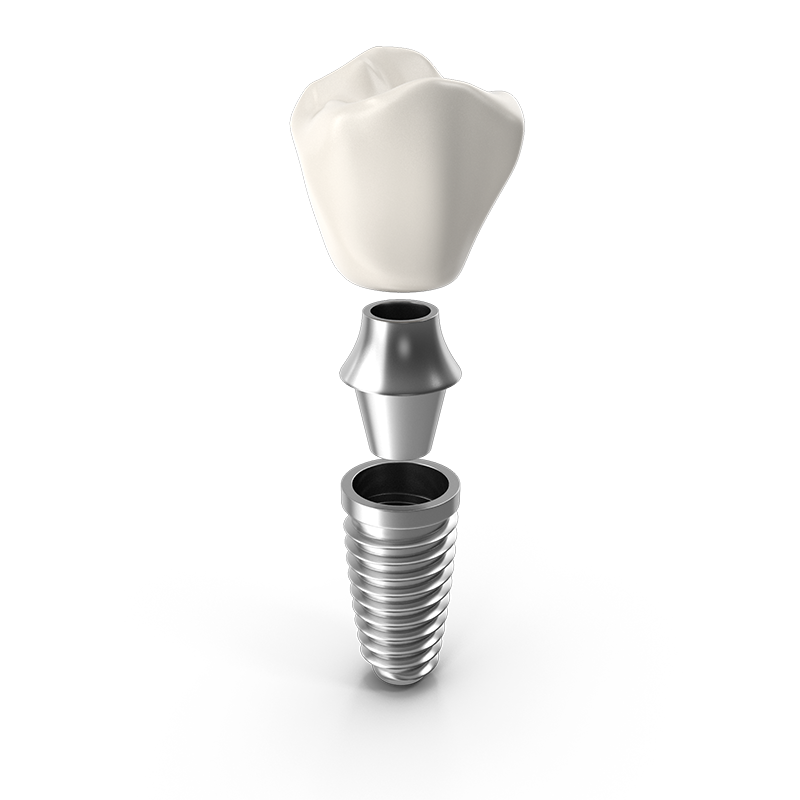The procedure to place a dental implant is relatively short and easy. The number of appointments and time required, vary from patient to patient. The surgeon will bring great precision and attention to the details of your case.
Prior to surgery, you may receive antibiotics and for greater comfort, an oral pre-medication or nitrous oxide (laughing gas). These options are discussed with you at your consultation appointment. A local anesthetic will be administered to numb the area where the dental implant will be placed.
When you are comfortable, the surgeon makes a small incision in the gum tissue to reveal the bone, creates space using special instruments, and the surgeon creates a small guide hole and gently inserts the titanium implant. The top of this implant is often visible through the gum. Sometimes it is better in the early stages of healing to have the implant covered by the gum tissue.
How do Dental Implants Work?
Dental Implants look, feel and function like natural teeth. When you lose a tooth, you lose both the root and the crown.
In replacing the tooth, we start by placing a small titanium implant into the jawbone which acts as the new root. We then allow some time for the jawbone surrounding the dental implant to heal.
Next, an abutment (support post) is placed on top of the implant
Then a new replacement crown (part that you eat with) is placed on top of the abutment.
Roll over the hot buttons on the image to get a better understanding of the anatomy of a dental implant.

Titanium Implant
Your periodontal surgeon places this piece into your jawbone. It acts as your new tooth root.
Abutment
This is the support post, connecting the implant to the crown.Crown
Your dentist will create this crown, designed to match the rest of your teeth in color and size for the most natural appearance.Healing after Dental Implant Surgery
The length of time varies from person to person, depending upon the quality and quantity of bone. In some cases, implants may be restored immediately after they are placed. The surgeon will advise you on follow-up care and timing. After the initial phase of healing, the surgeon places an abutment (support post) or a healing cap onto the dental implant during a brief follow-up visit. This allows gum tissue to mature and provides access to the implant.
Occasionally, impressions or 3D Photographic scans are made at the time the implant is placed. This enables the crown to be ready when the implants have healed. How long your mouth needs to heal is determined by a variety of factors. Follow-up care (one to four appointments) is usually needed to ensure that your mouth is healing well and to determine when you are ready for your crown to be placed on your implant.
It may be beneficial to perform a soft tissue graft to obtain stronger, more easily cleaned and natural appearing gum tissue in the area around the implant. This process is most often done at the time of surgery.
When are dental implants placed?
Implants are often placed several months after extraction. At times, an implant may be placed immediately after extraction of a tooth. When indicated, it simplifies the process—you won’t have to wait for another appointment to place the implant. When infection or other problems with the bone are present, immediate implant placement is not the best treatment.
If your tooth has been missing for some time, the adjacent support bone is likely to grow thinner and shrink. This occurs because the root of the natural tooth has to be present to stimulate the bone. As much as one third of your jaw’s thickness can be lost in the year following tooth extraction. If you are missing enough bone, you may benefit from having additional bone grafted into the area. This ensures the implant will be adequately supported when it is placed in the jaw.
How many implants do I need?
Most frequently, one implant per missing tooth is placed. Because many of the larger teeth in the back of your jaws have two or three roots, the most common approach is to replace missing back teeth with larger implants.